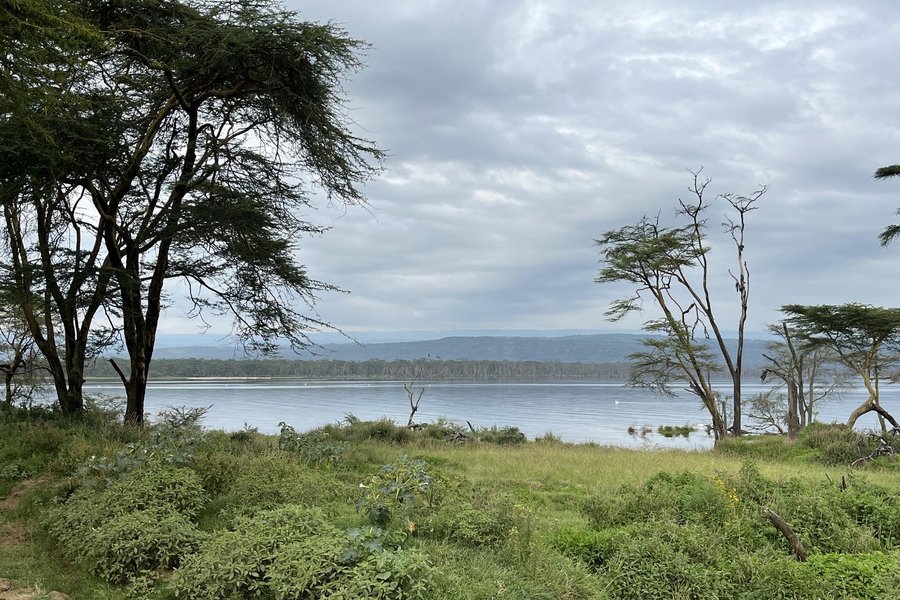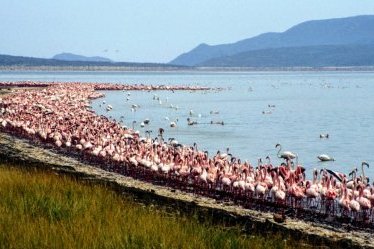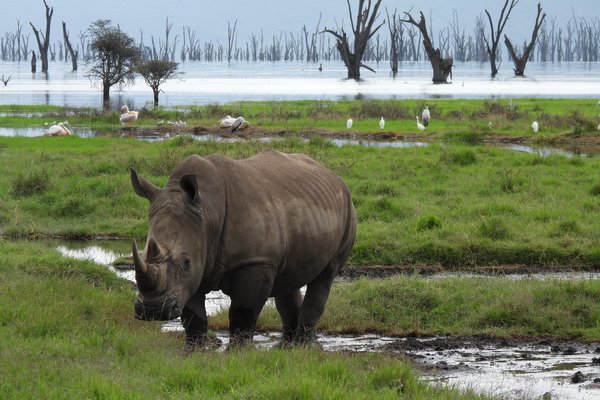Kenya
Kenya Lake System
The Kenya Lake System in the Great Rift Valley consists of three soda lakes in the valley basin, known for their high concentration of Lesser Flamingo.
Lake Elementaita, Lake Nakuru and Lake Bogoria are shallow, alkaline, and are hydro-geologically connected through sub-surface seepage of water. The alkalinity of the three lakes supports the abundant growth of the green algae, which is the food of the Lesser Flamingoes, which congregate in the lakes in great numbers, and also attract breeding Great White Pelicans and migratory birds.
Community Perspective: Due to frequent flooding, the number of flamingoes in the lakes has been greatly reduced. The active and regular geysers and volcanic fumaroles at Lake Bogoria are worth visiting, while Lake Nakuru NP is proud of its black and white rhinos.
Site Info
Official Information
- Full Name
- Kenya Lake System in the Great Rift Valley (ID: 1060)
- Country
- Kenya
- Status
-
Inscribed 2011
Site history
History of Kenya Lake System
- 2011: Inscribed
- Inscribed
- 2001: Referred
- Referral at Bureau meeting as Rift Valley Lake Reserves: to make Lake Elementaita a protected area and completion of management plans for all three lakes.
- Type
- Natural
- Criteria
- vii
- ix
- x
Links
- UNESCO
- whc.unesco.org
- Official
-
- kws.go.ke — Lake Nakuru
All Links
UNESCO.org
- whc.unesco.org — whc.unesco.org/
Official Website
- kws.go.ke — Lake Nakuru
News Article
- March 17, 2022 theguardian.com — A drowning world: Kenya’s quiet slide underwater
Community Information
- Community Category
- Natural landscape: Rivers, Wetlands and Lakes
Travel Information
High entrance fees
Recent Connections
-
High entrance fees
60 USD for Lake Nakuru (it's a so-calle… -
Foreigner prices
Via the KWS park fee system (foreigners… -
Eocene
The East African Rift came into being a…
Connections of Kenya Lake System
- Geography
-
-
Notable lakes
Lake Elementaita, Lake Nakuru and Lake Bogoria -
Hot Springs
The Kenya Lake System presents an exceptional range of geological and biological processes of exceptional natural beauty, including falls, geysers, hot springs (OUV) -
Geysers
Lake Bogoria -
Lakes located in Rift Valleys
Great Rift Valley
-
- Ecology
-
-
Over 300 bird species
diverse avifauna with 450 species recorded (AB ev) -
Pelicans
"It is (...) a major nesting and breeding ground for great white pelicans." (Official description) -
Swamps and Marshes
"exceptional natural beauty, including falls, geysers, hot springs, open waters and marshes" (OUV) -
Rhino habitat
The park now (2009) has more than 25 black rhinoceros, one of the largest concentrations in the country, plus around 70 white rhinos. (wiki) -
Bird Migrations
The African-Eurasian Flyway -
Bovines
African Buffalo (UNEP-WCMC) -
Endorheic Lakes
"These lakes are relatively shallow (except Bogoria which has a maximum water depth of 19 meters), alkaline and endorheic (not having any surface outlet)." (AB ev) -
Critically endangered fauna species
Black Rhinoceros - "Population size collapsed during the last century, from an estimated 65,000 animals in 1970 to a mere 2,300 in the 1990s. Rhino numbers are now increasing, but recovery is slow" -
Lions
Lake Nakuru NP: 18-22 individuals in 2017 (see link) -
Flamingos
The Kenya Lake System is the single most important foraging site for the Lesser Flamingo in the world with about 1.5 million individuals moving from one lake to the other (OUV Crit X) -
Hippos
"major breeding grounds for the Nile crocodile, hippopotamus and a variety of venomous snakes." (AB ev) -
African Wild Dog
"features sizeable mammal populations, including black rhino, Rothschild's giraffe, greater kudu, lion, cheetah and wild dogs" (UNESCO Web Desc)
-
- World Heritage Process
-
-
Already inscribed still on T List
Lake Bogoria National Reserve, Lake Nakuru National Park -
Extension Supported
"at the time of inscription, the World Heritage Committee in its Decision 35 COM 8B.6 encouraged the States Parties of Kenya and the United Republic of Tanzania, and other relevant States Parties, to cooperate regarding the effective conservation of Lake Natron and other lakes in the region, and to consider further potential serial extensions as part of a potential transnational serial World Heritage property" -
Natural sites filling gaps cited by IUCN
Rift Valley Lakes habitat
-
- Human Activity
-
-
Natural sites with indigenous human population
The Endorois people were forced by the Kenyan government to leave their traditional homeland around Lake Bogoria in the 1970s. See link for current state of their fight to gain recognition of their rights and criticism of UNESCO/WHC and IUCN for allowing the inscriptionSee www.iucn.org
-
Indigenous groups expelled
Bogoria: Endorois. “The Government of Kenya forcefully evicted them from their area of habitation on the shores of Lake Bogoria after the Lake Bogoria Game Reserve was created in 1973.” (WHS-IPR)
-
- WHS on Other Lists
-
-
Ramsar Wetlands
Lake Nakuru (1990), Lake Elmenteita (2005), Lake Bogoria (2001)
-
- Timeline
-
-
Eocene
The East African Rift came into being approximately 40 million years ago as the African tectonic plate began to split
-
- Visiting conditions
-
-
High entrance fees
60 USD for Lake Nakuru (it's a so-called Premium Park), 50 USD for Lake Bogoria -
Foreigner prices
Via the KWS park fee system (foreigners pay 60 USD for Nakuru, Kenyans 860KSh (about 7 USD))
-
News
- theguardian.com 03/17/2022
- A drowning world: Kenya’s quiet sl…
Recent Visitors
Visitors of Kenya Lake System
- Afshin Iranpour
- Alberto Rodriguez Gutierrez
- Ali Zingstra
- A. Mehmet Haksever
- Ammon Watkins
- AmyAbroad
- amychemu
- Ask Gudmundsen
- Aspasia
- Atila Ege
- Bram de Bruin
- Carlos Sotelo
- Dan Pettigrew
- dave wood
- David Marton
- Deffra
- DouglasR
- Elf21
- Els Slots
- Erik Jelinek
- Eva Kisgyorgy
- Fan Yibo
- Gernot
- hegeline@icloud.com
- Iain Jackson
- Ingrid
- Jacob Otten
- Javier Coro
- JobStopar
- Joyce van Soest
- KarenBMoore
- Knut
- kutasp
- Laurine
- Ludvan
- Luis Filipe Gaspar
- MarcoB_0
- MaxHeAnouBen
- MaYumin
- M.HATADA
- Michael Ayers
- Michael Novins
- Monica66
- Morodhi
- Nihal Ege
- PabloNorte
- Pat Martin
- Patrik
- Paul Schofield
- Peltzi
- Piotr Wasil
- Randi Thomsen
- Roman Bruehwiler
- Solivagant
- Stanislaw Warwas
- stephanvermeulen
- Svein Elias
- Thomas Buechler
- Thomas van der Walt
- Tim Allen
- Timothy C Easton
- Vanessa Buechler
- V&M
- wantrain.
- Waxwing
- Wo_ko
- Yongcheng Liu
- Zoë Sheng
Community Reviews
Show full reviews
It’s a miracle that this WHS is not In Danger, or that this issue is not being discussed. Since approximately 2015, the Kenyan Lake System has experienced severe flooding. The causes are not yet fully understood, but higher annual rainfall, degradation of the surrounding land due to deforestation and urbanization, and even possibly ‘closing’ of the tectonic plates under the Rift come into play. The floodings keep the flamingoes away from their once favourite habitat as they cannot wade in deep waters and the level of water salinity has changed as well. All 3 criteria that make up the Lake System’s OUV are at least partly related to those flamingoes (“the single most important foraging site for the Lesser Flamingo in the world with about 1.5 million individuals moving from one lake to the other”), and these numbers simply are not present anymore. To make matters worse, the smallest of the included lakes, Elementaita, seems already beyond repair according to IUCN in its Outlook 2020 because of uncontrolled development of its surroundings and the partial loss of Ramsar conservation status.
Kenya has submitted a State of Conservation report of the Lakes to this year's WHC, and with funding from the Dutch government, hopes to fulfill all recommendations that it hasn’t been able to accomplish on its own for the past decade (the additional funding is 45k USD, which to me seems like a drop in the ocean).
I visited the area via a half-day private safari in Lake Nakuru …
Keep reading 0 comments
I visited Lake Elementaita in March 2019 as this is the easiest lake to get to without paying high entrance fees and/or hiring a 4WD. I tried to go to Lake Nakuru as well with the National Park bus tour as well but after waiting for two hours in the bus at Nakuru bus station, only 10 passengers turned up which was not considered enough to run the bus.
Lake Elementaita I could visit by just getting off a matatu from Nakuru and then I walked down from the main road. I entered through a hotel gate and the friendly guard let me through, asking for a small fee if I happened to come back via the same path.
The alkaline gives a pretty reflection of the sun in the water, especially in late afternoon. Alongside the shore, the mineral deposits look interesting, with cracks running along it. I walked along the shore for perhaps five kilometers and encountered a few shepherds with their sheep, who were very kind and curious. I saw just a few flamingos in the lake in the distance, maribu storks are more abundant.
When the sun started setting, I walked back to the main road to wait for a matatu back to Nakuru which materialized within minutes.
Keep reading 0 comments
Across the years since my first visit to Kenya in 1975 we have visited each of the 3 inscribed lakes. The photo is of Lake Bogoria and our visit there in 1991 is the one we remember best – for the flamingos of course, but also for the active and regular geysers and volcanic fumaroles and, finally, the road to get there!! We had rented a 4x4 and were rough camping. The so-called “road" we took into the lake from the south (we wanted the more remote southern camp site) was VERY boulder strewn with sharp volcanic rocks and we acquired punctures in 2 different tyres at the same time. Unfortunately we only had 1 spare wheel and no air pump! Ah well, all part of the “adventure”! Unless they have improved the road we recommend taking the northern entrance. Flamingos move around and couldn't, even in those days, be guaranteed in large numbers at all sites but we were pleased with the numbers when we were there – if you can only visit one lake try to find out before hand which has flamingoes at that time. From what we saw, Bogoria didn’t really offer much else in the way of wildlife viewing beyond birds – Nakuru on the other hand is presented as more of general “Wildlife park” with a wide range of (re-)introduced mammals including Lion, Rhino and Leopard. I remember it as somehwat “zoo-like” compared with e.g the Mara and Samburu, as it is situated just …
Keep reading 0 comments



